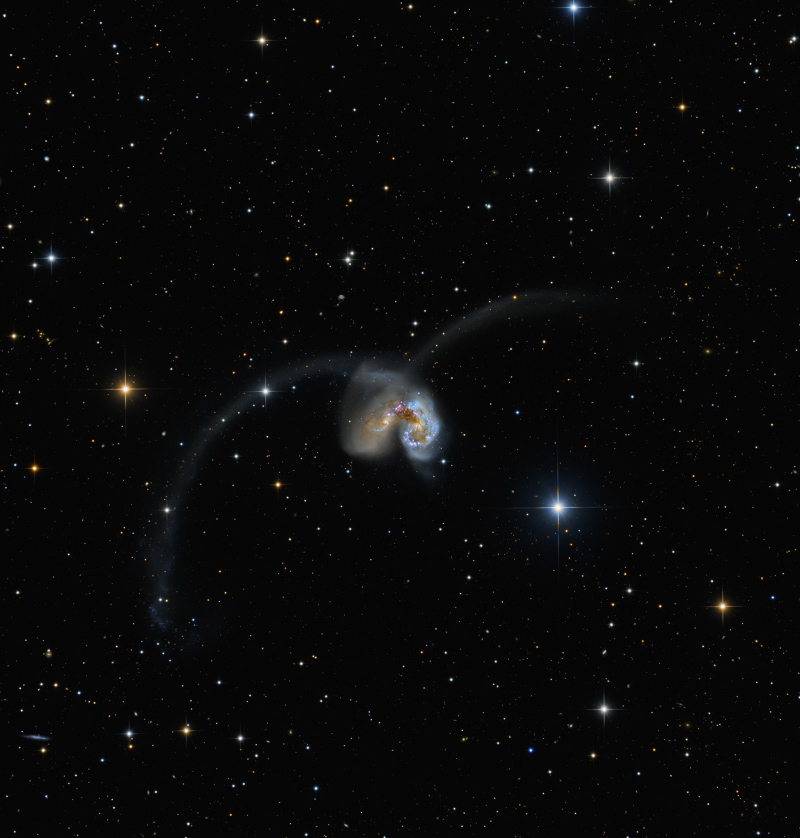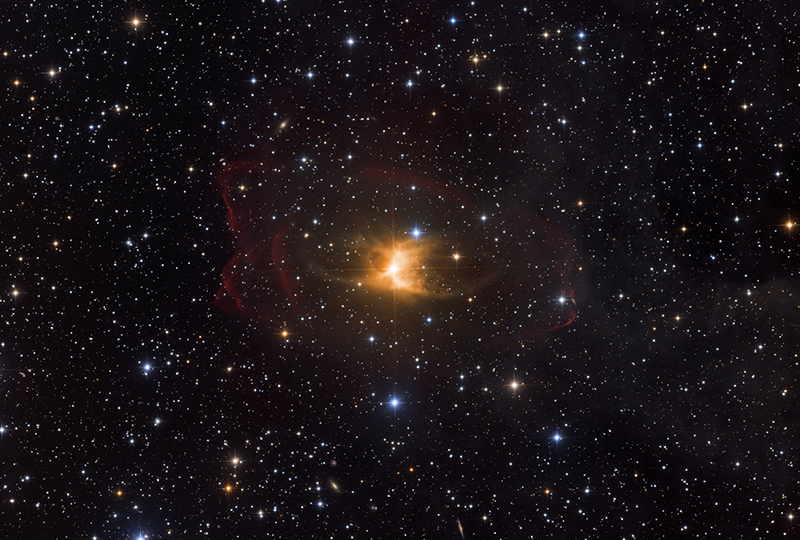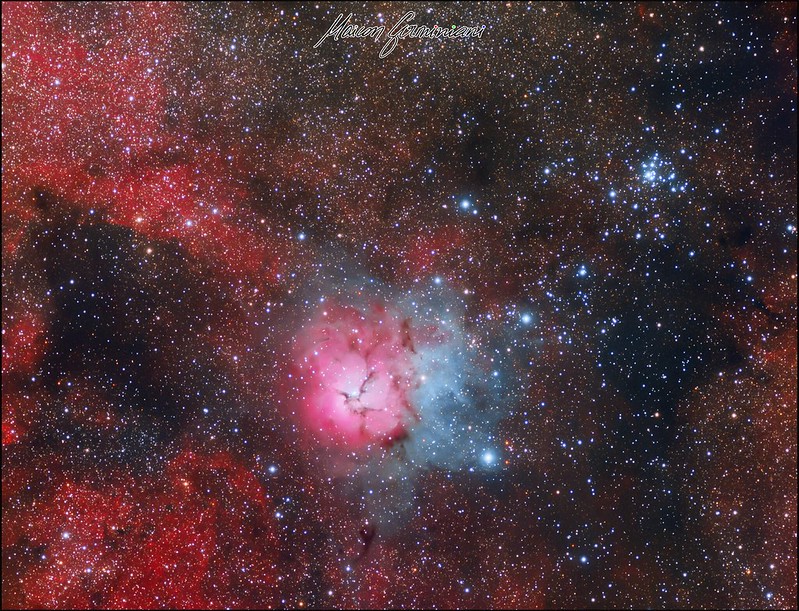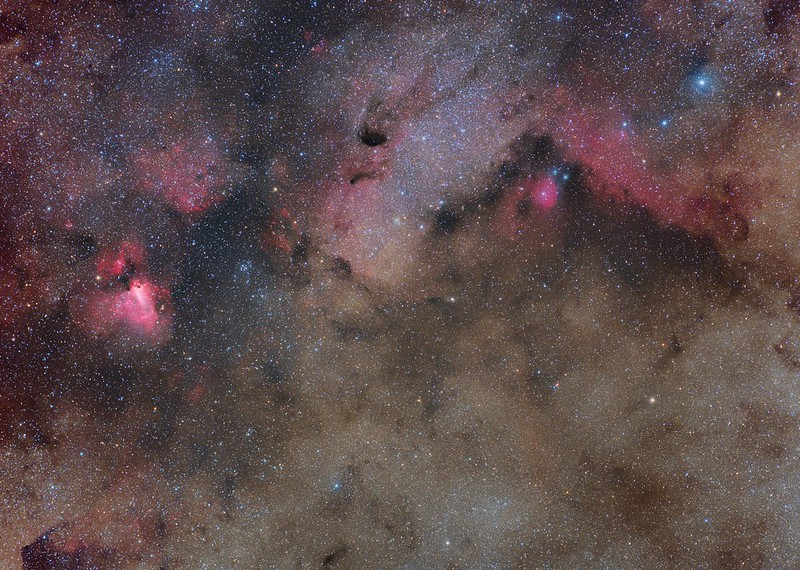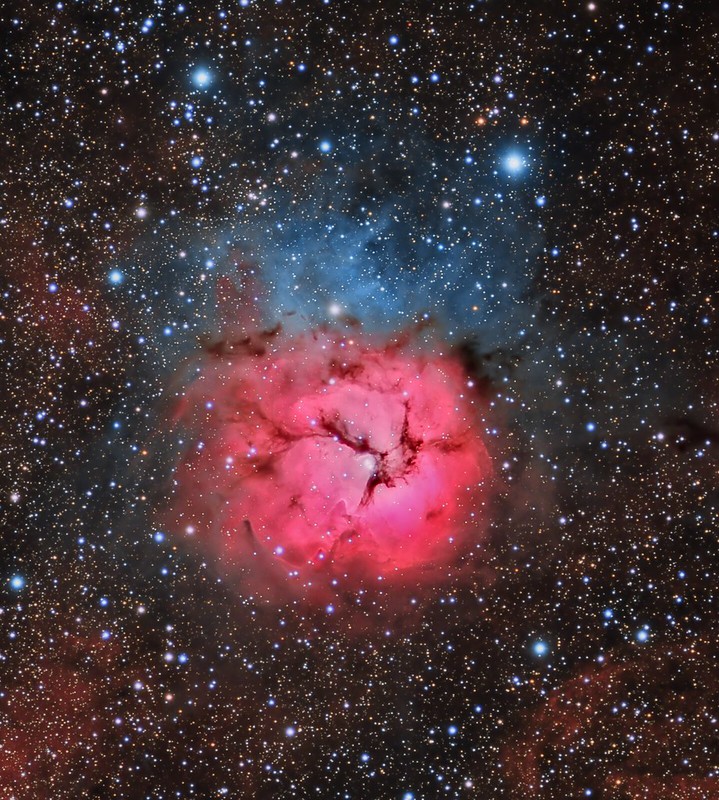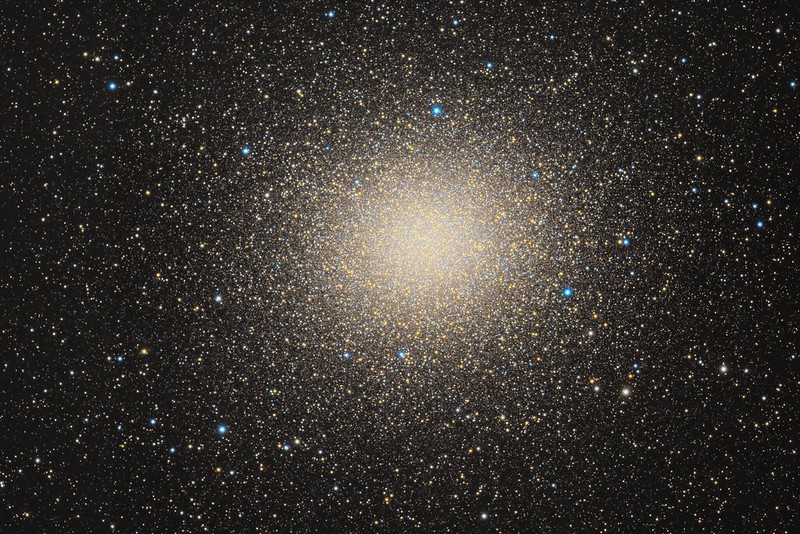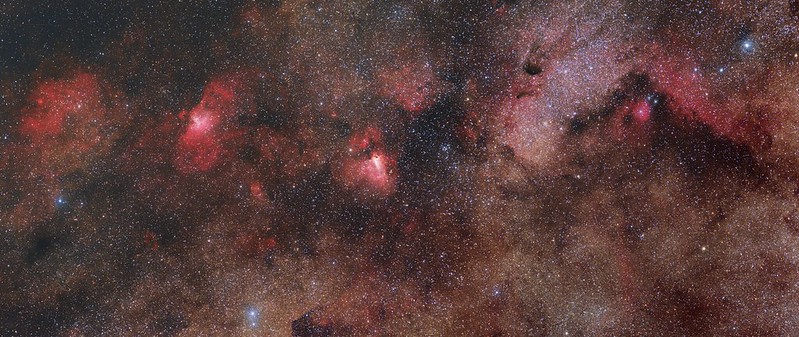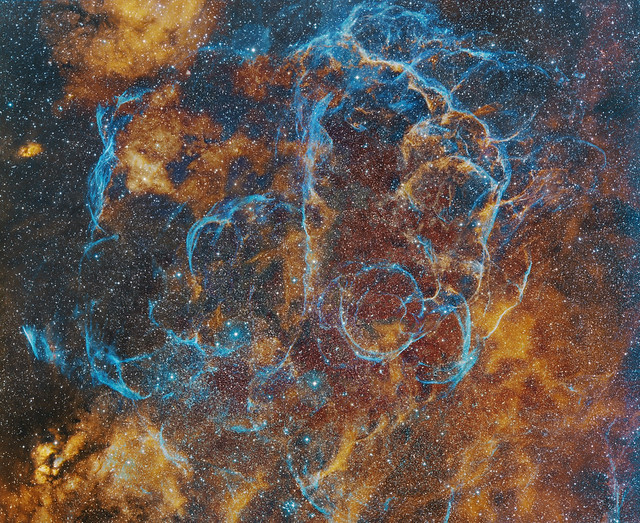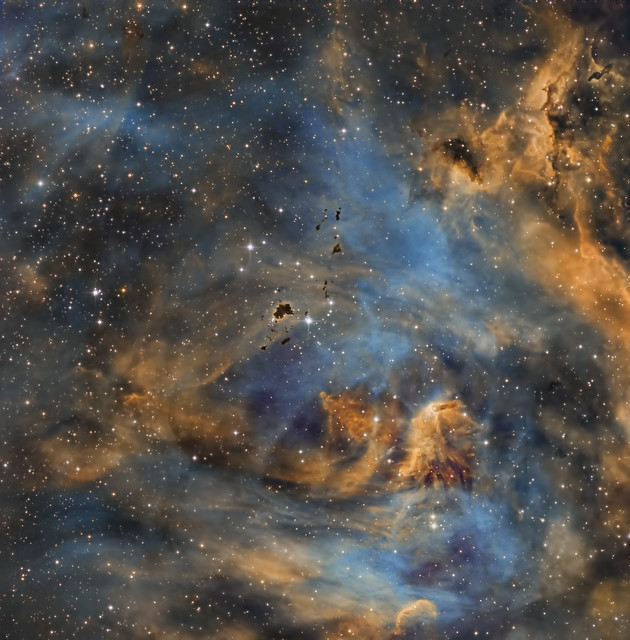Submissions: 2022 March
Re: Submissions: 2022 March
Sh2-216, Sh2-221 in Auriga
Equipment used:
Samyang 135 / 2.0 lens, Atik460EX camera,
Integration:
Ha: 110 x 5 min.
OIII: 110 x 5 min.
R, G, B: 25x 90 sec. each filter
Higher resolution image: https://i.ibb.co/sRtwRQR/Sh2-216-221-70prc.jpg
Copyright: Evzen Brunner
Samyang 135 / 2.0 lens, Atik460EX camera,
Integration:
Ha: 110 x 5 min.
OIII: 110 x 5 min.
R, G, B: 25x 90 sec. each filter
Higher resolution image: https://i.ibb.co/sRtwRQR/Sh2-216-221-70prc.jpg
Copyright: Evzen Brunner
Re: Submissions: 2022 March

Imaged over two nights between dusty weather and clouds that did not want me to image Thor's helmet this year.
I imaged Thor's Helmet nebula from Kuwait in a bortle 6/7 zone
a total of 80frames at 300 seconds each 40 Ha and 40 Oiii
the equipment used were:
Skywatcher esprit 100
Zwo asi2600mm
Ioptron cem40 mount
Processed in Pixinsight and Photoshop
feel free to check out more of my work on instagram @mi7sen89
or on astrobin user name Mi7sen
much Regards and clear skies!
-
SpookyAstro
- Science Officer
- Posts: 117
- Joined: Sat Feb 07, 2015 7:38 pm
Re: Submissions: 2022 March
 The Amazing Clouds of Orion by Transient Astronomer, on Flickr
The Amazing Clouds of Orion by Transient Astronomer, on FlickrImage credit and copyright Nicolas Rolland, Terry Hancock, Tom Masterson. Grand Mesa Observatory www.grandmesaobservatory.com
-
mdieterich
- Science Officer
- Posts: 100
- Joined: Fri Feb 13, 2015 5:50 pm
Re: Submissions: 2022 March
Orion
www.mattdieterich.com
Copyright: Matt Dieterich and Mike Selby The constellation of Orion in the night sky is filled with absolutely beautiful deep-sky objects. When a small telescope and sensitive camera under dark skies is pointed at Orion then many of these objects can be revealed.
In order to bring an exciting amount of depth to Orion I captured a 12-panel mosaic that in total comprises 70-hours of exposure time. I used a Skywatcher 80mm refractor telescope and QHY600 camera (binning 1) with HaLRGB filters from ObsTech in Chile.
This was a team effort and Mike Selby helped me iron out the mosaic stitching to make this final image possible. To give you an idea just how high resolution this mosaic is the final 12-panel dimensions are 26.1 ft x 18.3 ft at 72 DPI. With this 61 MP camera sensor that resulted in a file 22,536 pixels x 15,840 pixels and 17gb when editing.
www.mattdieterich.com
Copyright: Matt Dieterich and Mike Selby The constellation of Orion in the night sky is filled with absolutely beautiful deep-sky objects. When a small telescope and sensitive camera under dark skies is pointed at Orion then many of these objects can be revealed.
In order to bring an exciting amount of depth to Orion I captured a 12-panel mosaic that in total comprises 70-hours of exposure time. I used a Skywatcher 80mm refractor telescope and QHY600 camera (binning 1) with HaLRGB filters from ObsTech in Chile.
This was a team effort and Mike Selby helped me iron out the mosaic stitching to make this final image possible. To give you an idea just how high resolution this mosaic is the final 12-panel dimensions are 26.1 ft x 18.3 ft at 72 DPI. With this 61 MP camera sensor that resulted in a file 22,536 pixels x 15,840 pixels and 17gb when editing.
-
SolarSystem
- Asternaut
- Posts: 2
- Joined: Sat Dec 18, 2021 3:55 am
Re: Submissions: 2022 March
Hello,
Follows 'The dog and the Milky Way' and an extract from its description that I highly would like to add:
"Remember to look up at the stars and not down at your feet. Try to make sense of what you see and wonder about what makes the universe exist. Be curious. And however difficult life may seem, there is always something you can do and succeed at."
Stephen Hawking
Regards
Manuel Natale
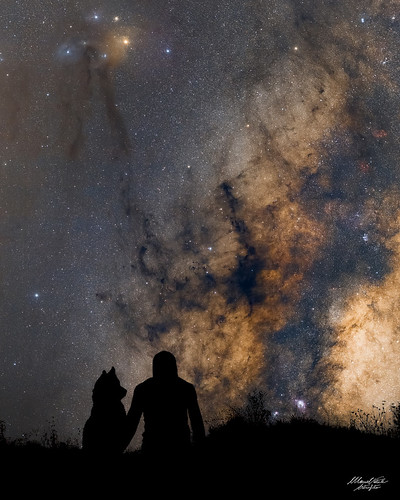
The dog and the Milky Way by Manuel Natale, on Flickr
Follows 'The dog and the Milky Way' and an extract from its description that I highly would like to add:
"Remember to look up at the stars and not down at your feet. Try to make sense of what you see and wonder about what makes the universe exist. Be curious. And however difficult life may seem, there is always something you can do and succeed at."
Stephen Hawking
Regards
Manuel Natale

The dog and the Milky Way by Manuel Natale, on Flickr
-
Carballada
- Ensign
- Posts: 22
- Joined: Sat Mar 16, 2019 10:19 am
Re: Submissions: 2022 March
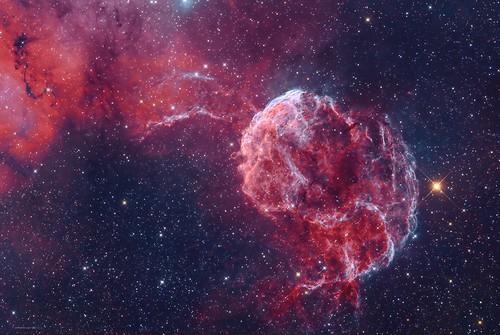
JellyFish Nebula (IC443) in natural colors
This images is a result of a 65 hours of integration time using rgb and narrow band filters.
IC 443 (also known as the Jellyfish Nebula and Sharpless 248 (Sh2-24) is a galactic supernova remnant (SNR) in the constellation Gemini.
Its distance is roughly 5,000 light years from Earth.
IC 443 may be the remains of a supernova that occurred 3,000 - 30,000 years ago.
IC 443 is one of the best-studied cases of supernova remnants interacting with surrounding molecular clouds.
-
Looten Julien
Re: Submissions: 2022 March
A zodiacal light at the "Dune du Pilat" (in France)
https://www.flickr.com/photos/julienloo ... en-public/
Copyright: Looten Julien
https://sendeyo.com/updownload/file/scr ... b7339.webp
This amazing triangular glow emanates from the horizon towards the sun. In this photograph, it starts from the middle of the dune (next to the silhouette) and extends towards the Milky Way. It is caused by the reflection of sunlight on space dust…. This photograph was taken at the top of the Dune du Pilat, towards the Atlantic Ocean (towards the west), where light pollution is absent. . In this photograph, you can also see many celestial objects and the Milky Way: the Pleiades in the center (clusters of bluish stars), the California Nebula (red nebula above the Pleiades) or Barnard's Loop (quite left), and other globular clusters. .
.
 : This photograph is not a montage/composite at all. - 5 minutes of exposure (30s unit)
: This photograph is not a montage/composite at all. - 5 minutes of exposure (30s unit)
Canon 6d Astrodon, Canon 16mm f/4.
Saturday March 5, 2022 - around 10 p.m.
Treatment on Ps.
Thank's in advance
Best regards
https://www.flickr.com/photos/julienloo ... en-public/
Copyright: Looten Julien
https://sendeyo.com/updownload/file/scr ... b7339.webp
This amazing triangular glow emanates from the horizon towards the sun. In this photograph, it starts from the middle of the dune (next to the silhouette) and extends towards the Milky Way. It is caused by the reflection of sunlight on space dust…. This photograph was taken at the top of the Dune du Pilat, towards the Atlantic Ocean (towards the west), where light pollution is absent. . In this photograph, you can also see many celestial objects and the Milky Way: the Pleiades in the center (clusters of bluish stars), the California Nebula (red nebula above the Pleiades) or Barnard's Loop (quite left), and other globular clusters.
Canon 6d Astrodon, Canon 16mm f/4.
Saturday March 5, 2022 - around 10 p.m.
Treatment on Ps.
Thank's in advance
Best regards
Last edited by bystander on Wed Mar 09, 2022 5:02 pm, edited 2 times in total.
Reason: Please, no hot links to images > 500 kb.
Reason: Please, no hot links to images > 500 kb.
-
barretosmed
- Science Officer
- Posts: 482
- Joined: Thu Oct 12, 2017 6:04 pm
Re: Submissions: 2022 March
HORSEHEAD NEBULA AND FLAME NEBULA
It is approximately 1500 light years from Earth.
BEST DETAILS:
https://www.astrobin.com/full/ts2xls/0/
EQUIPMENTS:
APO TS 80MM
10 X 200 BIN2 G, 4 X 200 BIN2 B, 15 X 200 BIN2 R, 20 X 300 BIN1 L
LOCATION: JALES - SP
DATES: DECEMBER 26 TO 28, 2019
Author: Fernando Oliveira de Menezes
(Organizing author of the book Amateur Astrophotography in Brazil)
https://clubedeautores.com.br/livro/ast ... -no-brasil
It is approximately 1500 light years from Earth.
BEST DETAILS:
https://www.astrobin.com/full/ts2xls/0/
EQUIPMENTS:
APO TS 80MM
10 X 200 BIN2 G, 4 X 200 BIN2 B, 15 X 200 BIN2 R, 20 X 300 BIN1 L
LOCATION: JALES - SP
DATES: DECEMBER 26 TO 28, 2019
Author: Fernando Oliveira de Menezes
(Organizing author of the book Amateur Astrophotography in Brazil)
https://clubedeautores.com.br/livro/ast ... -no-brasil
Re: Submissions: 2022 March

Hi,
Full version here :
https://www.astrobin.com/9baoyu/
https://flic.kr/p/2n7B2PL
During our stay at the Baronnies Provençales observatory, we were able to shoot this project that we had been preparing for a while, this beautiful set of nebulae in the Auriga constellation.
After the SHO version (which you can see on Christophe's profile), here is the HOO version.
However, we used the S layer as follows:
Use of an SHO mix as luminance in order to have more signal and detail thanks to the Sii.
Added a hint of Sii in the HOO mix.
The main difficulty was the assembly of data from setups with different focal lengths and sensors and the creation of mosaics for each layer.
This collaboration, from the preparation of the project, to the processing, including the trip and the shoot, was a great technical and human experience.
Technical part:
Takahashi FSQ106 EDX4 with super reducer 645-QE
Takahashi FSQ85 EDX with reducer 0,75-QE
Asi 2600MM Pro
Asi 294MM Pro
Antlia filter RVB
Antlia filter OIII 3nm
Antlia filter Ha SII 3.5nm
Eq6r-pro
Ioptron CEM70
Guiding Altaïr 60/225 + asi 290mm mini & OAG
Acquisition: N.I.N.A + Phd2 / Asiair Pro
Integration time: 39h40
Processing: Siril + PixInsight + Photoshop
Taken between 01/30/2021 and 02/03/2022 in France
Copyright: Yann SAINTY & Christophe VERGNES
Re: Submissions: 2022 March
Iris Nebula and Molecular Clouds in Cepheus
A dusty 6.25° × 4.0° large region in Cepheus containing NGC 7023 (Iris Nebula) and VdB 4141 (Ghost Nebula). The image was shot with SDSS I', R' and G' filters. Regions known as dark nebulae are reddish because they become transparent in infrared light (mapped to red).
Click on the image for detailed information and full resolution pictures.
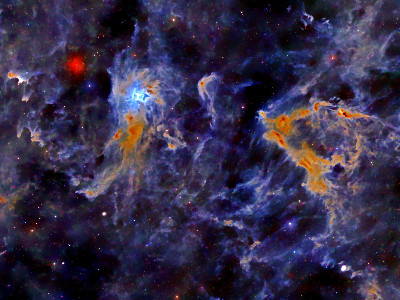
---
My Homepage
RSS news feed
A dusty 6.25° × 4.0° large region in Cepheus containing NGC 7023 (Iris Nebula) and VdB 4141 (Ghost Nebula). The image was shot with SDSS I', R' and G' filters. Regions known as dark nebulae are reddish because they become transparent in infrared light (mapped to red).
Click on the image for detailed information and full resolution pictures.

---
My Homepage
RSS news feed
Milky Way from Taurus to Perseus
Milky Way from Taurus to Perseus
A 25°×35° wide-field view of Milky Way in the constellations Taurus, Auriga and Perseus is presented in different color composites. Many famous nebulae like Spaghetti Nebulae, IC 405 and IC 410 can be seen near the galactic plane. The region south of it is full of Molecular clouds. Behind them there lies a larger HII complex which contains the California Nebula.
The previews show a false color version with H-alpha and continuum, a pseudo color image only containing H-alpha (both with reduced stars) and an almost-true color image without star reduction. Click on the thumbnails for more information, selected details and full resolution pictures (>100 MPixel).



---
My Homepage
RSS news feed
A 25°×35° wide-field view of Milky Way in the constellations Taurus, Auriga and Perseus is presented in different color composites. Many famous nebulae like Spaghetti Nebulae, IC 405 and IC 410 can be seen near the galactic plane. The region south of it is full of Molecular clouds. Behind them there lies a larger HII complex which contains the California Nebula.
The previews show a false color version with H-alpha and continuum, a pseudo color image only containing H-alpha (both with reduced stars) and an almost-true color image without star reduction. Click on the thumbnails for more information, selected details and full resolution pictures (>100 MPixel).



---
My Homepage
RSS news feed
aquatic acquisition
SH2-308 The Dolphin Head Nebula
24 shots at 600 seconds each shot from my backyard with a ZWO ASI2600MC camera, William Optics GT81 telescope, and Losmandy GM811G equatorial mount. Taken Dec 3rd, 2021
24 shots at 600 seconds each shot from my backyard with a ZWO ASI2600MC camera, William Optics GT81 telescope, and Losmandy GM811G equatorial mount. Taken Dec 3rd, 2021
Re: Submissions: 2022 March
NGC4038
Copyright: Wolfgang Promper http://www.astro-pics.com/4038rcm.htm
Copyright: Wolfgang Promper http://www.astro-pics.com/4038rcm.htm
Re: Submissions: 2022 March
IC2220
Copyright:Wolfgang Promper http://www.astro-pics.com/2220rcm.htm
Copyright:Wolfgang Promper http://www.astro-pics.com/2220rcm.htm
-
germinianimaicon
-
germinianimaicon
-
germinianimaicon

